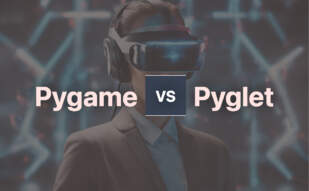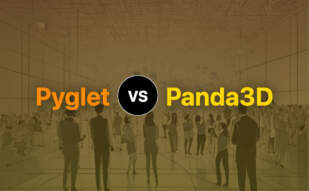Pygame is a Python module used for game development, released in 2000 and currently at version 2.5.0. It simplifies real-time game development and is notable for its cross-platform capabilities and community-driven content creation.

For those exploring options beyond Pygame, alternatives encompass Pyglet, Arcade, Tkinter, Kivy, LibGDX, Raylib, SDL, SDL2, OpenGL, Panda3D, Love2D, MonoGame, LÖVE, and SFML.
Pyglet
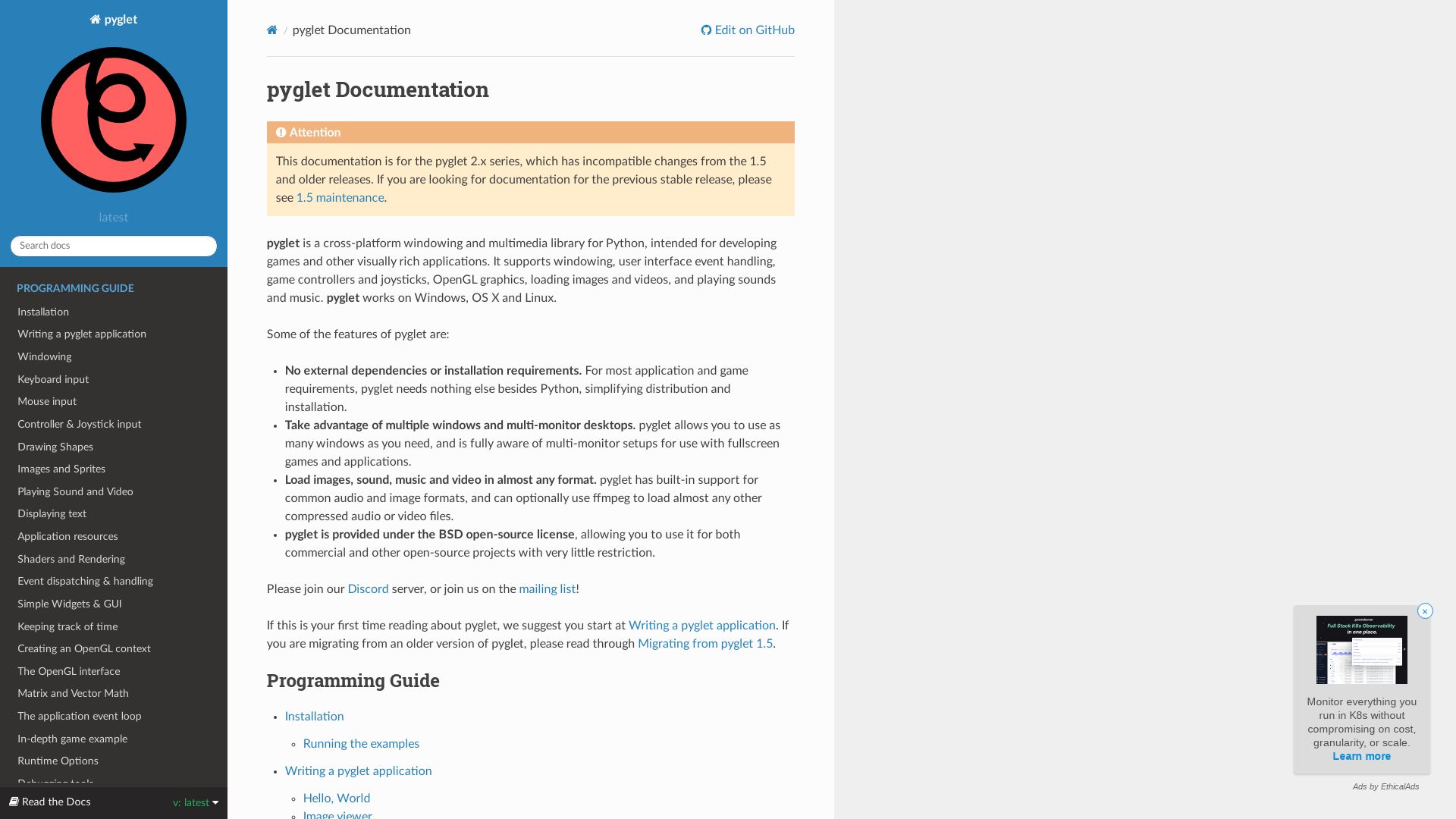
Embrace yourself to meet Pyglet! A language sweeter than Python and a toolkit packed-to-the-brim for all your game development desires. This open-source haven is approved by Microsoft Windows, prettied up for macOS, and even penguins (Linux) are in on the fun. Pyglet’s motto? To bring simplicity and versatility to game development and beyond.
Pyglet’s Top Features
- It doesn’t rely on anyone: With no external dependencies, Pyglet is as independent as a game engine can get.
- Do you window? Pyglet sure does: With its windowing abilities, multi-window and multi-monitor desktops are a breeze.
- About as open-source as can be: Provided under BSD open-source license, it’s free for all – commercial and open-source projects both.
- It plays nice with others: It works in harmony with Python 2 and Python 3.
| Feature | Why it’s Cool |
|---|---|
| Active community | Got a bug? Hit a wall? Need a shoulder to cry on? Pyglet’s pro-active community is just a click away. Troubleshooting has never been this social! |
| Excellent compatibility | It keeps up with the times. Compatible with several Python GUI libraries like PyQt, PyGame, and Raw XLib, Pyglet doesn’t discriminate! |
| Pure Python codebase | Efficiency is key! Pyglet’s pure Python codebase and advanced batching lets you draw thousands of objects with style and speed. |
Pyglet Drawbacks
- Its minimalistic nature may require additional libraries for more advanced features
- Not the best choice for 3D game development with complex graphics requirements
Pyglet Pricing
Rejoice! Pyglet is free. It’s open-source, it’s ready, and it’s waiting for you.
Pyglet Use Cases
Use case 1: Indie Game Developers
Are you an indie game developer looking for a no-frills, self-sufficient engine? Pyglet is what you need! With Pyglet, making the next “Battlefield 2” or “Pirates of the Caribbean” could be just a coding session away.
Use case 2: Multimedia Applications
Who said Pyglet is only for games? Want to create multimedia applications that sing and dance (not literally)? Pyglet’s easy setup and extensive features will let you choreograph a hit!
Use case 3: GUI Development
If you’re into creating engaging GUI – Pyglet will be your partner in design. Its compatibility with various Python GUI libraries is a testament to Pyglet’s versatility and cooperative spirit.
Arcade

Entrenching itself within Python’s gaming enclave is Arcade, a free and open-source 2D game development engine. The brainchild of computer science savant, Paul Vincent Craven, Arcade dazzles with its modern Python prowess, heralding an evolution from Pygame.
ARCade’s Top Features
- Intuitively incorporated into Python 3.6+, providing limitless integration potential and the blessing of type hinting.
- Remarkable compatibility stretching across Windows, Mac OS X, Linux facilitated by foundational OpenGL 3.3+ support.
- The ropes of basic drawing are simplified, requiring no advance knowledge of defining functions or classes.
- Inherent audio capabilities, with tools like load_sound, play_sound, and set_sound_volume functions creating immersive auditory experiences.
- Leans on unique Sprite feature, enabling object creation for diverse animations, seamlessly woven into the crevices of gaming and graphic applications.
| Unique Feature | Description |
|---|---|
| League System | Special system to create realistic motion in games. |
| Power of OOP | A clear shift toward object-oriented programming, encouraging the creation of classes based on arcade.Windows. |
| Cartesian Coordinate System | Simplifies drawing with inbuilt specifications, placing (0,0) at the screen’s lower-left corner. |
Arcade’s Limitations
- Dances with instability, posing a challenge for complex, ongoing projects.
- Struggles with backward compatibility, occasionally introducing breaking changes in updates.
- Despite a resourceful library, Arcade’s documentation can appear scant, requiring debugging through long examples.
Arcade Pricing
Spellbound by the allure of Python’s green snake? Arcade echoes Python’s principles, standing tall as an entirely free and open-source engine. Carve out your game development dreams without fearing the invoice.
Arcade Use Cases
Use Case 1: Indie Game Developers
Independent developers, take a bow. Arcade simplifies the game creation process with its intuitive and easy-to-use features. Without the shackles of a steep learning curve, focus on bringing your unique vision to life.
Use Case 2: Educators
For educators seeking a practical demonstration of Python, Arcade offers engaging, hands-on learning. Harness Arcade’s simplicity to draw out Python’s capabilities to your learners.
Use Case 3: Graphic Designers
Graphic designers, look no further. Arcade’s varied program features enable creation of simple and filled shape drawing variants, painting a canvas for your design ingenuity.
Panda3D

Developed for 3D game creation and rendering, Panda3D is a robust game engine, written primarily in C++ and Python. A project born out of Disney’s VR Studio, it has since grown into a widely acclaimed open-source engine supported by a vibrant community of developers
Panda3D Top Features
- Support for Python and C++: Both languages are fully supported, providing flexibility and functionality for the developers. Python is used for scripting while C++ for engine writing.
- Automated Engine Structures: Panda3D simplifies management of engine structures through Python’s garbage collector.
- Comprehensive Functionality: The engine offers an array of features including graphics, audio, I/O, collision detection, and more. It essentially furnishes everything needed for 3D game creation.
- Rich Graphic Enhancements: Panda3D comes equipped with custom shaders, modern per-pixel lighting techniques, gloss map, and normal map. It also includes automatic shader synthesis for advanced visuals.
- Open-Source: Panda3D is available for free. Its source code is accessible and open for modifications, expanding opportunities for customisation.
| Additional Features | Description |
|---|---|
| 3D Audio | Supports FMOD, OpenAL or Miles Sound System for implementing 3D sound. |
| Physics System and Collision Detection | Essential for realistic game mechanics and environments. |
| Extensive Documentation and Community Support | Provides a wealth of information and assistance to developers worldwide. |
Panda3D Disadvantages
- It is not aimed at beginners. Panda3D requires a fundamental knowledge of Python and APIs, making it more suitable for professional use.
- Despite its openness to bug reports, certain bugs might take time to be addressed owing to the free and open source nature of the project.
Panda3D Pricing
As an open-source project, Panda3D is completely free to download and use. It also allows for financial support through its OpenCollective campaign, further emphasizing its community-driven nature.
Panda3D Use Cases
Use Case 1: Large Commercial Games
Studios developing large-scale games with robust functionality and outstanding graphics can leverage the power and versatility of Panda3D, as demonstrated by its use in games like Toontown Online and Pirates of the Caribbean Online.
Use Case 2: Open-Source Projects
Given its open-source nature, Panda3D serves as an ideal game engine for open-source projects where customizability and community engagement are paramount.
Use Case 3: University Courses
The engine’s support for Python and C++ makes it an excellent tool for academic use in courses emphasizing game development and 3D rendering.
Love2D
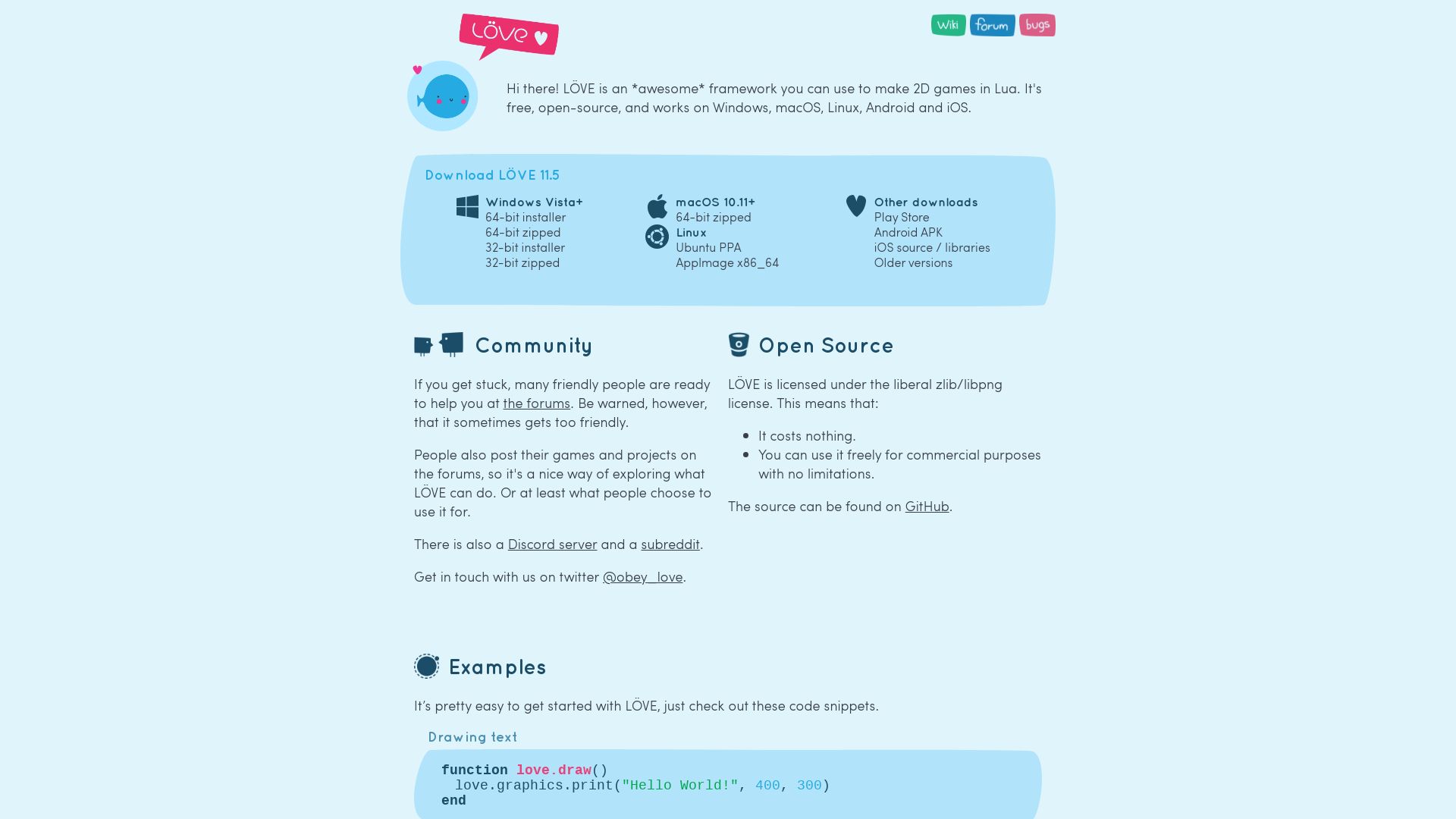
An open-source, free framework, Love2D is a noteworthy contender in the 2D game development realm. Initially released on January 13, 2008, it supports various platforms and languages, boasting cross-compatibility.
Love2D Top Features
- Utilizes the Lua scripting language, affording flexibility and quick prototyping.
- Robust support for video functions, sound functions, OpenGL pixel shaders GLSL, and joystick controls.
- Compatible with prominent libraries like SDL and OpenGL, supporting an inclusive development sphere.
- Compatibility with audio formats such as WAV, OGG, and MP3, and image formats PNG, JPEG, GIF, TGA, BMP.
- Integrates physics engine Box2D, and LuaSocket library for effective network communication.
- A strong presence in game development competitions, testifying to its applicability.
| Library | Compatibility |
|---|---|
| SDL | Yes |
| OpenGL | Yes |
| FreeType Engine | Yes |
Love2D Disadvantages
- Strict focus on 2D can restrict the scope in an increasingly 3D gaming world.
- Comparatively, lacks the sophisticated power of game engines like Unreal and Unity.
- Limited module availability and absence of a graphical interface may present development hurdles.
- There is no guarantee that cross-platform games will work seamlessly across different Love2D versions.
Love2D Pricing
Being open-source, Love2D comes at no cost. It thrives on an enthusiastic community, strengthening its footing with the zlib License.
Love2D Use Cases
Use case 1 – Indie Game Developers
For Indie game developers seeking an accessible, flexible, and cost-efficient engine, Love2D offers a strong platform. The integration of Lua scripting is a prime asset, enabling rapid development cycles.
Use case 2 – Educational Institutions
Educational institutions teaching game development can leverage Love2D due to its simplicity and dedicated 2D game space, making it an ideal learning tool.
Use case 3 – Game Jams
Given Love2D’s history in game jams, it’s a formidable choice for participants, lending itself to quick prototyping and competitive creative crafting.
MonoGame

Behold the grandeur of MonoGame, a lauded C# framework erected in the year 2009 by the MonoGame Team, available to the masses, without charge. It is esteemed for its multifarious platform support, extending its influence to television with tvOS, and to the vast landscapes of Android and iOS, among others.
MonoGame Top Features
- A reincarnation of the Microsoft XNA 4 API, it possesses the power to recreate games of notable prominence like Bastion and Celeste.
- It has evolved from its early focus on 2D sprite-based games to now accommodate 3D graphics since 2013.
- Paying homage to its roots, MonoGame employs the magic of OpenGL, OpenGL ES, or DirectX for rendering, and follows XNA 4 ContentManager model for content management.
- It is ushered forward by independent software developers, imbuing it with a unique sense of dynamism and development freedom.
| Key Feature | Description |
|---|---|
| Multiple Platform Support | It supports a bevy of platforms including iOS, macOS, Linux, PlayStation, and Xbox, to name a few. |
| Developer Control | Its mainstay is lower-level programming, primarily C#, offering comprehensive control over the game development process. |
| Community-Sourced | Community maintained, where every developer can contribute to improve documentation, tutorials, codes or videos. |
MonoGame Limitations
- The framework caters to those seasoned in lower-level programming, rendering it a less than optimal choice for those seeking higher-level programming methods.
- It lacks an integrated game editor or a WYSIWYG (What You See Is What You Get) environment.
- Frequent updates and optimization for non-Windows platforms are among its unfulfilled promises.
MonoGame Pricing
A salute to the spirit of open-source, MonoGame is accessible without any financial burdens, though for iOS and Android, paid support is required.
MonoGame Use Cases
Use Case 1 – Aspiring Developers with Basic Programming Skills
MonoGame serves as a compelling option for game developers aiming to weave magic across multiple platforms. Existing knowledge of basic C# programming is a prerequisite.
Use Case 2 – Indie Game Development
MonoGame is an ideal choice for independent game developers due to its indie-friendly, code-focused C#-based game engine.
Use Case 3 – Legacy XNA Projects
For developers tasked with maintaining or enhancing legacy XNA projects, MonoGame, with its reimplemented Microsoft XNA 4 API, presents itself as an apt solution.
LÖVE
A free, open-source and cross-platform game framework, LÖVE, empowers game developers worldwide. Notably, it embraces an interactive approach, inviting code modifications to see real-time results.
LÖVE Top Features
- Open-source and usage under the zlib license
- Written in C++ and uses Lua as the scripting language
- Supports multiple platforms including Microsoft Windows, macOS, Linux, Android, iOS
- Hardware acceleration and multi-threading support
| Compatibility | Special Features |
|---|---|
| OpenGL ES 2 and 3 support | Offers features like OpenGL pixel shaders GLSL, touchscreen support, joystick interface |
| Fonts rendered by the FreeType engine | UTF-8, image and media formats support |
| Ported version “piLöve” available for Raspberry Pi | Developers can modify code and see changes in real time |
LÖVE Limitations
- It might have a steep learning curve for beginners due to the Lua scripting language
- A potential lack of advanced features compared to some proprietary engines
LÖVE Pricing
Being an open-source game development engine, LÖVE comes at the delightful price of free.
LÖVE Use Cases
Use case 1
Game developers who aim to create seamless cross-platform games may find LÖVE’s extensive platform compatibility highly amusing.
Use case 2
Participants in game development competitions like Ludum Dare could utilize a versatile and quick development framework like LÖVE.
Use case 3
For coders seeking an interactive coding experience, LÖVE’s feature of modifying code and seeing changes in real time presents a unique opportunity.
SFML
The Simple and Fast Multimedia Library, also known as SFML, is a C++ library majorly recognized for its game development properties. Since its first release in August 2007, SFML has been an open-source platform that supports Linux, macOS, Windows, FreeBSD, and offers language bindings such as Ada, C, Crystal, D, Euphoria, Go, Java, Julia, .NET, Nim, OCaml, Python, Ruby, Rust and mobile ports to Android and iOS.
SFML Top|Best Features
- 2D graphics acceleration for smooth gaming performance.
- FreeType text rendering for clear, crisp in-game text.
- OpenAL audio to enhance gaming soundtracks and effects.
- Support for 3D sound effects to create a more immersive experience.
- TCP/UDP network communication, offering network programming capabilities for multiplayer gaming.
| Modules | System classes, window management, input devices, OpenGL context management, graphics, audio, network |
| GitHub stars | 8,774 stars as of June 20, 2023 |
| Installation requirements | CMake, SFML 2.0, C++ compiler |
SFML Limitations|Disadvantages|Downsides
- Lack of official tutorials for the different language bindings supported.
- Need for C++ knowledge may limit accessibility for novice programmers.
- No explicit support for mobile ports beyond Android and iOS, hindering reach to other mobile platforms.
SFML Pricing
As an open-source platform, SFML is free to use for any and all interested parties.
SFML Use Cases
Use case 1
Independent developers aiming to create 2D games with intricate sound designs and networking capabilities can find SFML as a viable tool.
Use case 2
Hobbyist game developers looking to understand and explore the basics of game development with hands-on experience can utilize SFML for development and learning purposes.
Use case 3
Small companies that wish to build lightweight and efficient games with a tight control on resource management can leverage SFML’s provisions for efficient game logic, graphics, audio, user input, and physics.
Tkinter
Meet Tkinter: Python’s de facto standard for crafting GUI applications. This open-source software is a comprehensive Python binding to the Tk GUI toolkit and is commonly included with standard install packages on popular platforms like Linux, Microsoft Windows, and macOS.
Tkinter Top Features
- Flexibility: It offers a mix of Python and Tcl in a single application thanks to its Python wrapper embedded in the Python interpreter.
- Modularity: It includes various widgets and modules to fine-tune the user interface and create highly interactive applications.
- ‘Themed Tk’ functionality, which enables native-looking themes since Python versions 2.7 and 3.1.
- Customized Display Settings: Leverage its object-oriented paradigm for a better reading experience.
| Feature | Explanation |
|---|---|
| Widget Offering | Includes a variety of widgets such as frames, buttons, text boxes, and more to build highly customized GUIs. |
| Pop-Up Dialogs | Modules like tk.messagebox, tk.filedialog, and tk.colorchooser help in creating intuitive pop-up dialogs. |
| Open-Source | Developed under the Python license, it embraces the ethos of open-source development. |
Tkinter Disadvantages
- Despite the flexibility, the intermingling of Python and Tcl can introduce a steep learning curve for beginners.
- With other alternatives like Kivy, Pygame, and PyGObject available, the adoption of Tkinter might need a deep evaluation.
Tkinter Pricing
Good news! Tkinter is available for free under the Python license, promoting open-source software development.
Tkinter Use Cases
Use case 1 – Desktop applications
With its high modularity, Tkinter proves to be instrumental in creating dynamic and custom desktop applications.
Use case 2 – Game Development
For budding game developers, Tkinter’s wide array of widgets can be an asset for drawing graphics and creating engaging user interfaces.
Use case 3 – Prototyping
Thanks to its native support and comprehensive toolkit, Tkinter allows rapid prototyping of applications – from simple to complex GUI designs.
Kivy
Deep in the tech undergrowth of game development engines stands Kivy, an open-source, Pythonic infrastructure known for fostering cross-platform, multi-touch applications.
Top Features of Kivy
- Primarily built with Python; compatible with Python 2 and 3.
- Offers a natural user interface that thrives on touch and gesture inputs.
- Stands out with impressive 2D and 3D graphics support, thanks to OpenGL and OpenGL ES 2 compatibility.
- Provides fast graphics rendering for visually engaging applications adorned with smooth animations and transitions.
- Rolls out dynamic, interactive UI components such as buttons, labels, and text inputs.
| Architecture type | Model-View-Controller (MVC) architecture |
| Application creation process | Inheriting Kivy’s App class, creating a build() method, calling the run() method |
| Community & Support | Active community, tutorials, and documentation available |
Kivy Disadvantages
- May present a learning curve to newcomers to the Kivy fold.
- Limited number of third-party libraries; the extensibility could be improved.
- Unlike other alternatives, Kivy lacks extensive community support which can sometimes impede progress.
- Potential performance issues when supporting complex apps.
Kivy Pricing
Remain, as Kivy is an open-source and MIT-licensed tool, it comes with a price tag or rather, a lack thereof. There is no cost associated with downloading, installing, or utilizing Kivy in your projects.
Kivy Use Cases
Use case 1: Creating Multi-touch Applications
Kivy shines uniquely when it comes to developing multi-touch applications. With its ability to process touch and gesture input, Kivy is comfortably suited to creating apps for smartphones and tablets.
Use case 2: Developing Visually Engaging Applications
For developers looking to design visually appealing apps with seamless animations and transitions, Kivy’s OpenGL compatibility offers fast graphics rendering.
Use case 3: Crafting Cross-platform Applications
With Kivy, you no longer need to toggle between tools to develop on different platforms. It stands ready to support applications on Windows, macOS, Linux, iOS, and Android platforms.
LibGDX
Dive into the rich waters of game development with LibGDX, an exceptional Java game development framework. With a shining legacy of over 10 years, this opensource tool bestows upon you the power of cross-platform targeting with a unified API.
LibGDX Top Features
- Leverages Java ecosystem providing IDEs, Git support, debuggers, profilers, libraries, and frameworks.
- Adaptable input handling system which supports mouse, keyboard, touchscreen, and controllers. Additionally, integrates accelerometer, gyroscope, and compass, enhancing the player’s experience.
- It offers a 2D physics via Box2D physics and 3D physics via Bullet physics. This enables realistic motion and action within your game.
- Direct PCM sample playback, recording features and audio streaming for WAV, MP3, OGG – a formidable sonorous setup.
- Extensive support for integration with Google Play Games, Apple Game Center, Firebase, AdMob, gameanalytics.com, and the Facebook Graph API.
| Graphics | Offers graphical features like Vertex arrays, buffer objects, meshes, textures, shaders, and 2D particle systems, ensuring an engaging visual canvas for your game. |
| UI Library | Enables intuitive interaction with user interface modules for fotearing superior gameplay experience. |
| Networking | Uses TCP sockets for networking, HTTP requests, and WebSocket support adding to the comprehensive game development suite. |
LibGDX Downsides
- LibGDX, being code-centric, requires strong programming skill-set to fully make use of its potential.
- Some developers may find it less intuitive than other visual-centric game development engines.
- The steep learning curve due to its highly extensive features and detailed control.
LibGDX Pricing
An ode to the spirit of coding and love for game development, LibGDX is absolutely free to use.
LibGDX Use Cases
Use case 1
If you are an indie game developer seeking fine-grained control, LibGDX’s code-centric approach gives you the reins of creativity. Benefit from the extensive features and third-party ecosystem to bring your vision to life.
Use case 2
For those looking for full community support, tutorials, and tools like Particle Editor and fbx-conv for importing 3D assets, LibGDX is the perfect ally. Its thriving community and detailed Wiki offer numerous resources for troubleshooting and enhancing skills.
Use case 3
Commercial developers targeting multiple platforms will find LibGDX with its unified API for cross-platform targeting a suitable choice. Its seamless integration of game services and in-app purchase features offer a seamless pathway to monetize your game.
libGDX
LibGDX is a powerful Java game development framework with cross-platform capabilities, trusted by developers for over a decade. It’s fully opensource and offers a ton of flexibility for game developers.
libGDX Top Features
- Unified API for cross-platform targeting: Windows, Linux, macOS, Android, iOS, Web.
- Rich graphics features such as vertex arrays, vertex buffer objects, meshes, textures, framebuffer objects, shaders, simple shape rendering.
- Support for OpenGL ES 2.0/3.0 rendering and extensive audio streaming options for different file formats.
- Input handling for mouse, keyboard, touchscreen, controllers, accelerometer, gyroscope and compass, along with gesture detection support.
- Easy integration with popular game services, and support for in-app purchases and AdMob Integration.
| 2D Physics | Box2D physics |
| 3D Physics | Bullet physics |
| Networking | TCP sockets, HTTP requests, WebSocket support. |
libGDX Limitations
- Being code-centric, it might require considerable coding knowledge and expertise compared to some other game development platforms.
- While its documentation is sound, beginners may find it initially challenging due to its broad feature-set and extensive control options.
- Platform updates or changes might require developers to update their own versions frequently.
libGDX Pricing
LibGDX is completely free to use and is licensed under Apache 2.0. Its open source nature also encourages community contribution and improvement.
libGDX Use Cases
Use case 1: Cross-platform game development
Thanks to its unified API, developers can use libGDX to create high-quality games for Windows, Linux, macOS, Android, iOS, and the Web.
Use case 2: Feature-rich game development
With its variety of graphics features, audio streaming options, and input handling, libGDX allows developers to create immersive gaming experiences for the end-users.
Use case 3: Startups & indie developers
Due to its free pricing and open source nature, libGDX provides a cost-effective solution for startups and individual developers, allowing them to harbor their creativity without worrying about costs.
Raylib
Emerging in the tech eco-sphere in November 2013, Raylib is a C-based, cross-platform game development engine. Conceived by Ramon Santamaria and team, its unique OpenGL abstraction layer, powerful modules and valuable integrations have been steering sustainable digital development since inception.
Raylib Top Features
- No External Dependencies: All required libraries included, counteracting software decay
- Multiplatform: For versatile development across Windows, Linux, macOS, FreeBSD, Android, Raspberry Pi, and HTML5
- Hardware Acceleration with OpenGL: For high performance and reduced energy consumption
- Built-in shader support for enhancing visual effects with reduced CPU load
- Sophisticated 3D Support: Including shapes, models, billboards, and heightmaps for realistic virtual environments that reduce physical prototypes
| Feature | Benefit |
|---|---|
| Over 50 programming languages bindings | Enables interoperability, reducing redundancy |
| Audio loading and playing support | Enhances user engagement and interaction |
| Integrated GUI module | Facilitates interface design for energy-efficient computing |
Raylib Limitations
- As a C-based engine, some gameplay features may require deeper programming knowledge
- Lack of a fully developed community means lower support for debugging and problem solving.
Raylib, Open Source and Free for Everyone
Adding to its eco-credentials, Raylib is entirely open source. Free for all, it encourages digital creativity while driving down the carbon footprint of software development.
Raylib Use Cases
Use case 1 – Educational Institutions
A powerful teaching tool, Raylib strengthens digital literacy and grooms future green developers.
Use case 2 – Prototyping
Raylib fast tracks prototyping, reducing material consumption and wastage.
Use case 3 – Embedded Systems
With an absence of external dependencies, Raylib makes a robust choice for creating long-life embedded systems for sustainable tech.
SDL
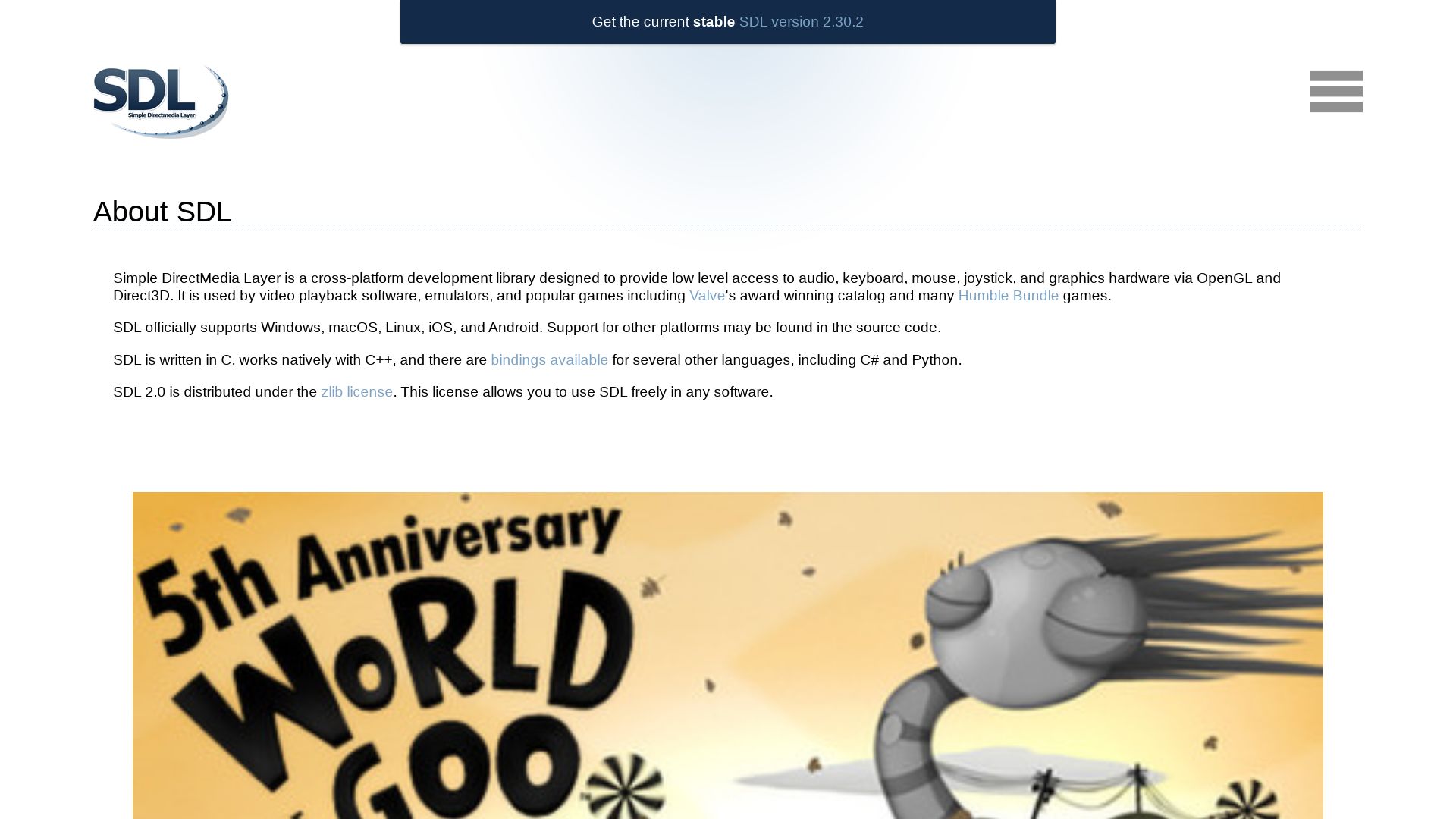
Welcome to the world of SDL, a sophisticated solution for game developers since 1998. Managed by the SDL Community, SDL was envisioned by Sam Lantinga to offer a uniform approach to multimedia hardware components, and it now integrates seamlessly into cross-platform software development.
SDL Top Features
- Support for numerous programming languages including C and C++.
- Efficient management of video, audio, input devices, CD-ROM, threads, shared object loading, and timers.
- Robust 3D graphics handling through OpenGL, Vulkan, Metal, and Direct3D11 contexts.
- SDL_image, SDL_net, SDL_mixer, SDL_ttf, and SDL_rtf extensions for enhanced functionalities.
- Advanced capability for 3D hardware acceleration, especially with SDL 2.0.
| Extension | Purpose |
|---|---|
| SDL_haptic.h | To contribute to complex audio functions for sound mixing. |
| SDL_audio.h | Handles intricate audio functions. |
| SDL_Collide (SourceForge) | Offers support for circular collision detection. |
SDL Limitations
- Lack of backwards compatibility with SDL 2.0, not suitable for projects needing a backwards-compatible API.
- Requires the latest DirectX SDK for building on Windows, could be a barrier for some developers.
SDL Use Cases
Use case 1: Cross-Platform Development
SDL serves a critical role in cross-platform software development with its uniform approach to handling platform-specific features. It considerably facilitates the software’s running capacity on Android, iOS, Linux, macOS, and Windows.
Use case 2: 3D Hardware Acceleration Support
The SDL 2.0 shines bright in offering increased opportunities for 3D hardware acceleration. Developers striving towards proliferating their 3D gaming experience would benefit from this feature.
Use case 3: Game Development using C++
For developers using C++, SDL proffers a robust groundwork for game development. With its inbuilt hardware-accelerated, texture-based rendering API, it’s an ideal solution for comprehensive object-oriented programming.
SDL2
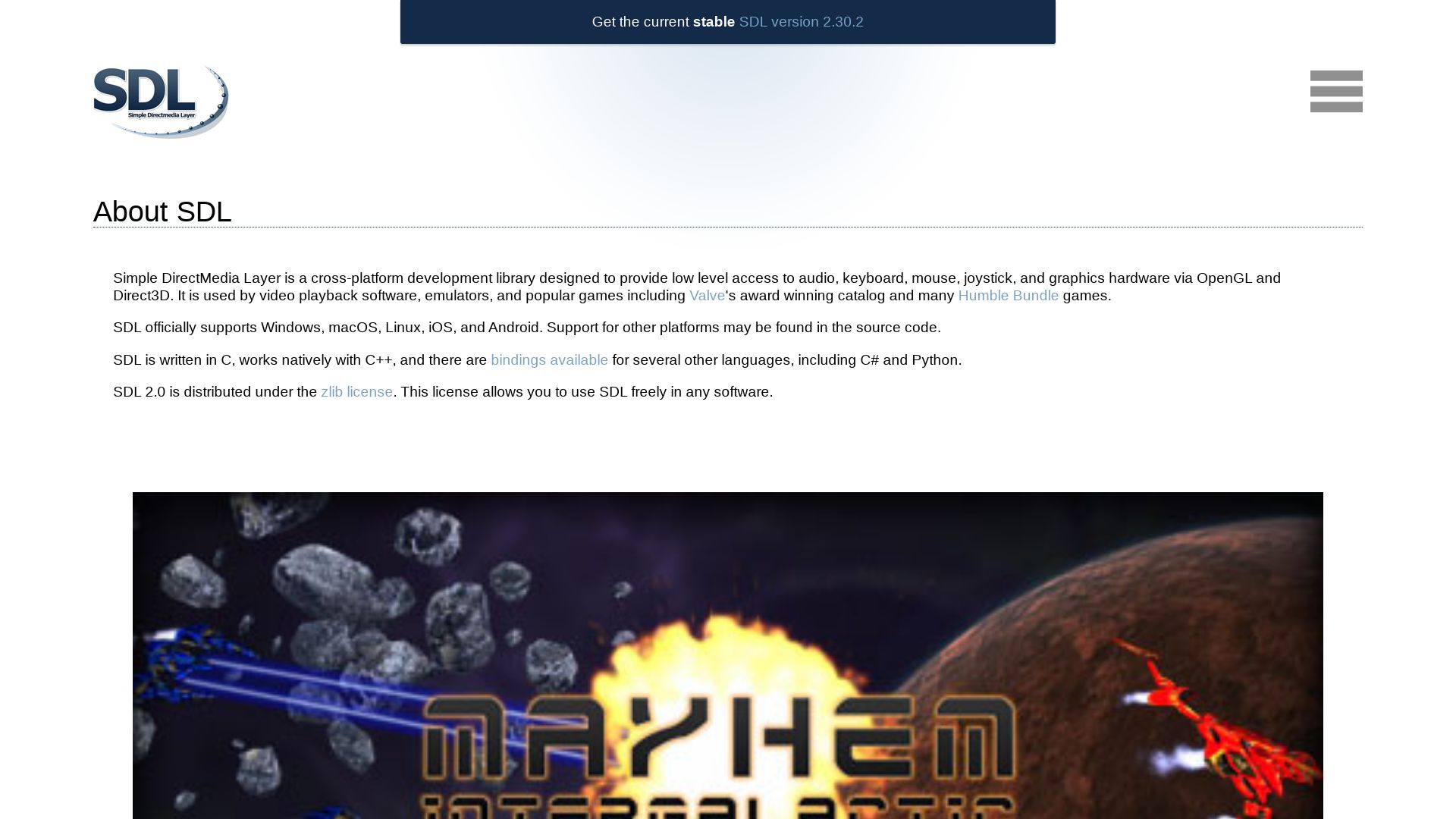
Meet SDL2, short for Simple DirectMedia Layer, an efficient low-level library for game development that supports various platforms.
SDL2 Top Features
- Provides hardware acceleration for 2D rendering
- Supports TrueType Fonts
- Incorporates sound and controller integration (keyboard, mouse, touchscreen, etc.)
| Resource | Focus |
|---|---|
| “SDL Game Development” by Shaun Mitchell | Practical tutorial guide for creating games using SDL 2.0 |
| Lazyfoo.net | In-depth SDL tutorials from basic 2D game creation to multithreaded programming and SDL compatibility with OpenGL for 3D game tech |
| Wololo.net | Insightful dev experiences, from wrapper codes and game creation to algorithm applications and data encryption |
SDL2 Limitations
- Initial efforts might focus on the structure of wrapper code
- Possibility of test game repetitions needed for function
- Lacks in-built support for complex pathfindingy algorithms
SDL2 Pricing
SDL2 is not just powerful, but also free and open source, making it an attractive choice for indie developers and larger studios alike.
SDL2 Use Cases
Use case 1
For those aiming to create 2D games, SDL2 accelerates the development process with its hardware-enhanced rendering.
Use case 2
When aimed at running games on less powerful machines (like a 2010 Intel Atom netbook), SDL2 proves its efficiency with minimal hardware requirements.
Use case 3
For developers intending to create game programs with embedded encryption systems, SDL2 offers simple XOR operations for game save data encryption.
OpenGL

First created in 1992 by Silicon Graphics, OpenGL (Open Graphics Library) is a mature and powerful low-level rendering and modelling software library. It was originally based on the proprietary IRIS GL and has since been established and managed by a consortium of 150 leading companies known as the Khronos Group.
OpenGL Top Features
- Hardware-accelerated 3D graphics support: OpenGL excels in creating efficient and high-performance 3D graphics, making it ideal for commercial games, scientific applications, and CAD programs.
- Augmented & Virtual Reality support: With its versatile capabilities, OpenGL is widely used for AR and VR development.
- Extensible: Developers have the ability to access advanced hardware-specific features via OpenGL extensions introduced in various versions over the years.
- Longstanding Updates: OpenGL boasts continued development and updating. Its latest version, OpenGL 4.6, introduced the SPIR-V language to define shaders, among other enhancements.
| Version | Notable Features |
|---|---|
| 3.3 | Recognized as the first “Modern OpenGL” version. |
| 4.0 | Introduced shading language 4.00 and features such as indirect drawing. |
| 4.3 | Added compute Shaders, image copying, and compatibility with OpenGL ES 3.1. |
OpenGL Limitations
- Prerequisite knowledge required: Understanding and utilizing OpenGL effectively requires prior knowledge of the C++ programming language and mathematics, particularly linear algebra, geometry, and trigonometry.
- Low-Level: As a low-level library, OpenGL necessitates manual management of many aspects, which can be intimidating for novices.
- Vulkan API: The Vulkan API is the successor to OpenGL, which means developers looking toward the future may wish to focus their efforts on the newer API.
OpenGL Pricing
As an open-source software library, OpenGL is free to use.
OpenGL Use Cases
Use case 1: Gaming
Several popular commercial games, such as ID Software’s Quake series, utilize OpenGL as their graphics engine, demonstrating its suitability for game development.
Use case 2: Scientific Applications
Drawing on its capacity for high-performance 3D graphics, OpenGL is commonly employed in various scientific applications.
Use case 3: CAD Programs
The robust 3D graphics support of OpenGL makes it useful in designing and manipulating complex 3D structures in Computer-Aided Design (CAD) programs.
Tiffany Brise
Content writer @ Aircada, patiently awaiting a consumer AR headset that doesn’t suck.



